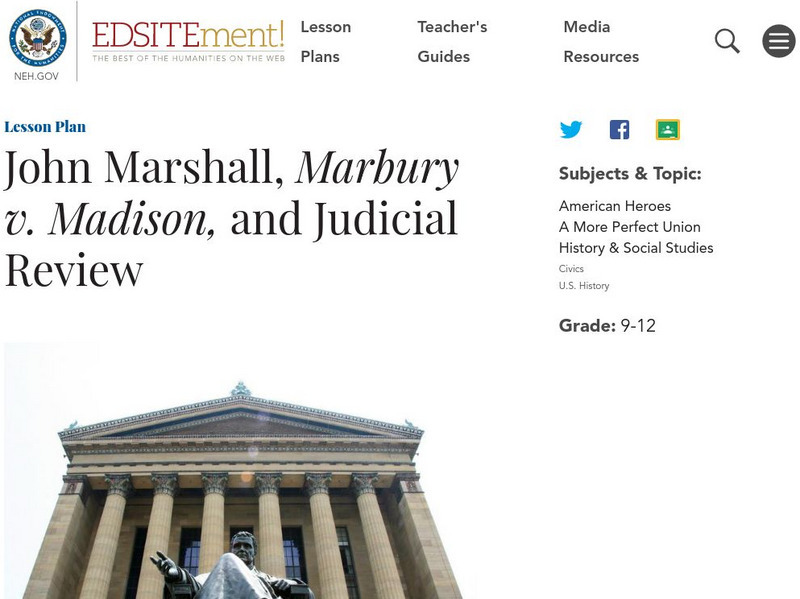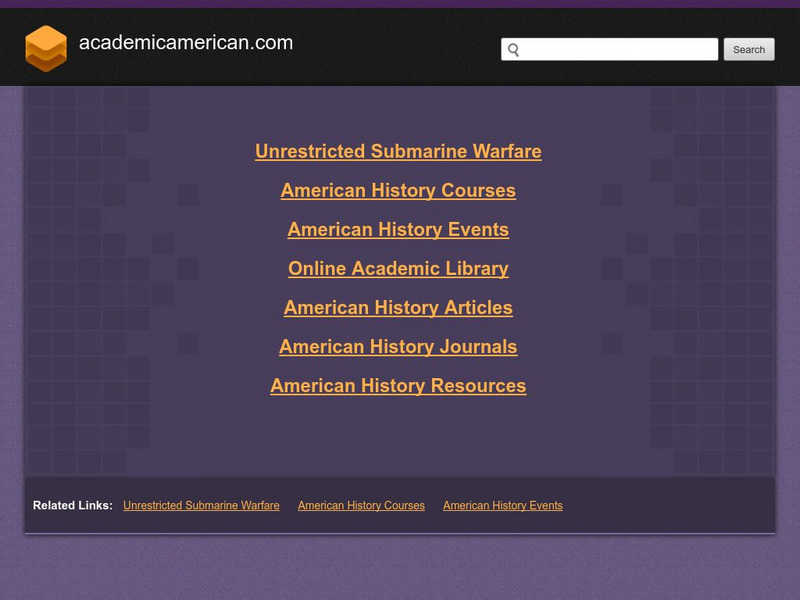National Endowment for the Humanities
Neh: Edsit Ement: John Marshall, Marbury v. Madison, and Judicial Review
In this lesson plan, students will consider "John Marshall, Marbury v. Madison, and Judicial Review-How the Court Became Supreme." The plan includes worksheets and other student materials that can be found under the resource tab.
PBS
Wnet: Thirteen: The Supreme Court: Landmark Cases: Marbury v. Madison (1803)
PBS features a summary of the landmark Supreme Court case of Marbury v. Madison, which deals with the principle of "judicial review." Opinion written by Chief Justice John Marshall.
Thomson Reuters
Find Law: u.s. Supreme Court: Marbury v. Madison (1803)
This resource contains the full text of the 1803 Supreme court case, Marbury v. Madison opinion.
Other
4 Law School: Marbury v. Madison
This article breaks down the facts of the Marbury v. Madison case, and briefly summarizes the Justices' opinions.
iCivics
I Civics: Marbury v. Madison (1803)
This mini-lesson covers the basics of the Supreme Court's decision that affirmed the Court's power of judicial review. Students learn how Congress tried to add to the Supreme Court's Constitutional power, how the Supreme Court rejected...
US National Archives
Nara: Charters of Freedom: The Power of the Courts: Marbury vs. Madison, 1803
Website with primary source material on the making of the U.S. government and Constitution explains how Marbury vs. Madison brought the power of Judicial Review to the Supreme Court.
This Nation
This Nation: Marbury v. Madison, 5 u.s. 137 (1803)
This resource provides the full text of the Supreme Court's decision in this landmark case, written by John Marshall.
Annenberg Foundation
Annenberg Learner: Democracy in Action. Federalism: u.s. V. the Sates
U.S. v. the States delves into the ongoing constitutional dilemma between the federal government and individual state governments illustrated through Video on Demand, activities, readings, etc.
Independence Hall Association
U.s. History: A Federalist Stronghold: John Marshall's Supreme Court
John Marshall was the fourth Chief Justice of the Supreme Court, but his decisions, especially in Marbury v Madison, set the influence of the Court for the next many decades. Read about Marshall's decisions and why they were so important.
Illinois Institute of Technology
Oyez Project: Marbury v. Madison (1803)
The U.S. Supreme Court case that established the precedent for judicial review is detailed, with an abstract providing a concise summary and a record of the justices that sat on the court at that time.
Other
Touro Law Center: William Marbury vs. James Madison
Transcript of the landmark court case that established the constitutional principle of judicial review. Judicial review is the concept that the federal judiciary has final power as to whether an act of the Congress or the Executive...
Digital History
Digital History: War on the Judiciary
The Judiciary Act of 1801 was a final attempt by the Federalists to control the judicial system before the Democratic Republicans took over. Read about the repeal of the act, which resulted in a landmark Supreme Court decision, Marybury...
iCivics
I Civics: Curriculum Unit Landmark Library
This library of mini-lessons targets a variety of landmark cases from the United States Supreme Court and includes a one-page reading and a one-page activity.
Other
Age of Jefferson and Jackson:john Marshall: The "Man Who Made the Court Supreme"
Read a thorough essay discussing the many important decisions handed down by the Supreme Court while John Marshall was Chief Justice. There are hyperlinks to each of the decisions.
Tom Richey
Tom richey.net: The Marshall Courts: Revenge of the Federalists [Ppt]
Presents key ideas for examining the impact of Supreme Court decisions under Chief Justice John Marshall on the powers of the federal government. Includes an activity at end of presentation.
OpenStax
Open Stax: Partisan Politics
By reading this section of a chapter on "The New Republic", students will be able to identify key examples of partisan wrangling between the Federalists and Democratic-Republicans, describe how foreign relations affected American...
Thomson Reuters
Find Law: History of the Supreme Court
This site gives insight into both the creation of the U.S. Supreme Court as well as its transformation to its present state. Throughout the text links can be found which lead to various Supreme Court topics and information.
PBS
Wnet: Thirteen: Supreme Court Landmark Cases
A website reviewing the Supreme Court's landmark cases, including Marbury v. Madison, Plessy v. Ferguson and the Slaughterhouse cases.
iCivics
I Civics: Judicial Review
This lesson explores the case that established the power the Supreme Court has today. Students will learn how the decision in Marbury v. Madison influenced the structure of the third branch, and how the Court's use of judicial review can...
Cool Fire Technology
Cool Fire Technology: Supreme Court Decisions
A listing of the most significant Supreme Court cases in the nineteenth and twentieth centuries with brief summaries of how they impacted on federalism.
iCivics
I Civics: Rule of Law
Students learn about the rule of law and how it protects individual rights and freedoms. By performing short, scripted skits that illustrate what life might be like without the rule of law, students identify six factors that make up the...
Annenberg Foundation
Annenberg Classroom: Executive Privilege
Check out this interactive timeline on excutive privilege in the United States.
University of Virginia
Miller Center at Uva: u.s. Presidents: Thomas Jefferson: Domestic Affairs
Read about Thomas Jefferson's attempts to make a smaller bureaucracy and his problems with the federal courts.
Social Studies for Kids
Social Studies for Kids: The Supreme Court
The Supreme Court is the highest in the land. It has nine members and decides whether laws are unconstitutional. It handles appeals from federal courts or state supreme courts. Learn more about how it works and some famous Justices.
















